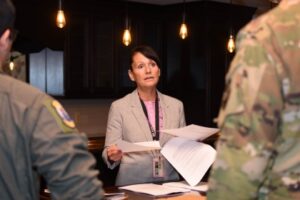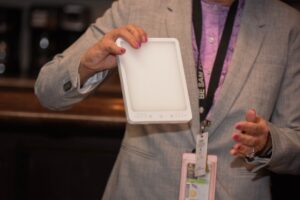Treatment Shows Effectiveness in Some Types of Depressive Disorders

Last year, Dr. Joan Cook, 89th Airlift Wing flight psychologist, discusses and displays a bright light therapy device during a presentation to the 1st Airlift Squadron and the 99th Airlift Squadron at Joint Base Andrews, MD. Photo by Staff Sgt. Garbrielle Winn,
AURORA, CO — Since the 1980s, when seasonal affective disorder was first identified, one of the first-line treatments has been Bright Light Therapy. In more recent years, BLT also has been increasingly tested in nonseasonal unipolar and bipolar depression, as well as conditions related to circadian system alterations.
Yet, a new study found that the therapy is greatly underused within the VA healthcare system. Less than 2% of the 3.4 million veterans who received outpatient mood disorder care over a 12-year period received a light-box consult, according to researchers from the VA Rocky Mountain Mental Illness Research, Education, and Clinical Center for Veteran Suicide Prevention and the University of Colorado Anschutz Medical Campus, both in Aurora, CO.1
“Bright light therapy (BLT) is efficacious for seasonal and non-seasonal depression,” the authors wrote in the Journal of Affective Disorders. “However, the current state of BLT use in practice is unknown, impeding efforts to identify and address utilization gaps. This study’s objective was to investigate BLT delivery in a nationwide U.S. healthcare system.”
To do that, researchers conducted a retrospective observational study of electronic medical records from all veterans who received outpatient mood disorder-related care in the VHA from October 2008 through September 2020. BLT delivery was measured through the placement of light-box consults.
Results indicated that, of the 3,442,826 veterans who received outpatient mood disorder care, only 57,908 (1.68%) received a light-box consult.
“Consults increased by 548.44 % (99.9 % credible interval: 467.36 %, 638.74%) over the timeframe and displayed a robust yearly cycle that peaked on either December 21st or December 22nd,” the researchers pointed out. “Past mental health treatment for a mood disorder was associated with a higher probability of a consult (relative risk = 4.79, 99.9 % CI: 4.21, 5.60). There was low representation related to veteran age, gender, race, and ethnicity.”
The study did not include information about patients who declined light boxes or actual light-box use following consult placement.
“Outpatient BLT delivery for mood disorders in the VHA remains low, despite significant growth over the past decade,” the study advised. “It also displays a strong seasonal rhythm that peaks on the winter solstice, suggesting a limited focus on seasonal depression and a suboptimal reactive approach to changing sunlight. Overall, there exists ample opportunity for novel implementation efforts aimed at increasing utilization of BLT.”

Dr. Joan Cook, 89th Airlift Wing flight psychologist, discusses and displays a bright light therapy device during a presentation to the 1st Airlift Squadron and the 99th Airlift Squadron at Joint Base Andrews, MD. Photo by Staff Sgt. Garbrielle Winn,
Background information in the article described how depressive illnesses are highly prevalent and disabling conditions that, despite decades of research and investment, “often show an underwhelming response to traditional treatments.” The authors pointed out, “a growing call for innovative approaches that can manage depression.”
The study found that veterans receiving a light-box consult were primarily male, White, and not Hispanic or Latino/a. Most of them were placed in mental health clinics, and more than 80 % of the light-box consults were for major depressive disorder or other mood disorders.
“The goal of this study was to investigate the characteristics of clinical BLT delivery in the VHA among veterans receiving outpatient care for a mood disorder,” the researchers wrote. “To the best of our knowledge, this is the first evaluation of BLT delivery within a large healthcare system using individual patient medical records. Since October 2008, weekly light-box consults in the VHA have increased by over 500%, reflecting a sustained growth in BLT delivery. Despite this, however, overall use remains minimal,” they explained.
The study emphasized that VHA’s outpatient use of BLT for mood disorders in the VHA remains low, even as use of BLT has grown over the past decade.
‘Ample Opportunity’
“Overall, there exists ample opportunity for novel implementation efforts aimed at increasing the utilization of BLT,” the authors added.
A systematic umbrella review published early last year by some of the same researchers pointed out that BLT is a promising nonpharmacological treatment for a range of psychiatric conditions.2
The report published in Chronobiology International was based on searches of Ovid MEDLINE, Embase, PsycInfo, Web of Science and Google Scholar for systematic reviews of randomized controlled trials (RCTs) evaluating BLT for any mental or behavioral illness from the date of inception until March 2021. The researchers assessed review quality using the AMSTAR 2 tool, and summary efficacy data were extracted from recent reviews.
Of 792 unique records, 67 systematic reviews were included that targeted a range of disorders related to mood, neurocognition, sleep and eating.
“Recent meta-analyses targeting seasonal or non-seasonal depression found that BLT outperformed light-related control conditions,” wrote the authors from VA Rocky Mountain Mental Illness Research, Education, and Clinical Center for Veteran Suicide Prevention and the University of Colorado Anschutz Medical Campus and colleagues. “Reviews of other disorders identified few RCTs and generally did not support the efficacy of BLT for various outcomes.”
On the other hand, they advised that available literature supports the efficacy of BLT for seasonal and nonseasonal depression, although they called for higher-quality systematic reviews to increase confidence in these findings.
A 2022 study led by the VA Portland, OR, Healthcare System looked at the use of morning bright light therapy to improve sleep in veterans with traumatic brain injury (TBI). “Mild traumatic brain injury (TBI) is associated with persistent sleep-wake dysfunction, including insomnia and circadian rhythm disruption, which can exacerbate functional outcomes including mood, pain, and quality of life,” the researchers wrote in PLoS One. “Present therapies to treat sleep-wake disturbances in those with TBI (e.g., cognitive behavioral therapy for insomnia) are limited by marginal efficacy, poor patient acceptability, and/or high patient/provider burden.”3
In response, the study team prospectively enrolled 33 veterans with history of TBI in a single-arm, open-label intervention using a lightbox (~10,000 lux at the eye) for 60-minutes every morning for four-weeks. The researchers used questionnaires related to sleep, mood, TBI, post-traumatic stress disorder (PTSD) and pain; wrist actigraphy as a proxy for objective sleep; and blood-based biomarkers related to TBI/sleep to determine pre- and post-study outcomes.
“The protocol was rated favorably by ~75% of participants, with adherence to the light box and actigraphy being ~87% and 97%, respectively,” the authors reported. “Post-intervention improvements were observed in self-reported symptoms related to insomnia, mood, and pain; actigraphy-derived measures of sleep; and blood-based biomarkers related to peripheral inflammatory balance. The severity of comorbid PTSD was a significant positive predictor of response to treatment.”
They concluded that morning bright light therapy is a “feasible and acceptable” intervention that shows preliminary efficacy to treat disrupted sleep in veterans with TBI but called for a full-scale randomized, placebo-controlled study with longitudinal follow-up to “assess the efficacy of morning bright light therapy to improve sleep, biomarkers, and other TBI related symptoms.”
- Reis DJ, Schneider AL, King SE, Forster JE, Bahraini NH. Delivery of bright light therapy within the Veterans’ Health Administration. J Affect Disord. 2023 Dec 26:S0165-0327(23)01516-1. doi: 10.1016/j.jad.2023.12.049. Epub ahead of print. PMID: 38154586.
- Reis DJ, Hoffberg AS, Stearns-Yoder KA, Bahraini NH. Bright light therapy for mental and behavioral illness: A systematic umbrella review. Chronobiol Int. 2023 Feb;40(2):204-214. doi: 10.1080/07420528.2022.2140669. Epub 2022 Nov 11. PMID: 36369785.
- Elliott JE, McBride AA, Balba NM, Thomas SV, et. al. Feasibility and preliminary efficacy for morning bright light therapy to improve sleep and plasma biomarkers in US Veterans with TBI. A prospective, open-label, single-arm trial. PLoS One. 2022 Apr 14;17(4):e0262955. doi 10.1371/journal.pone.0262955. PMID: 35421086; PMCID: PMC9009710.

